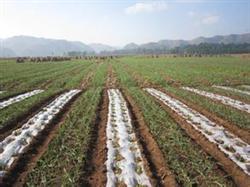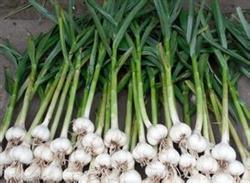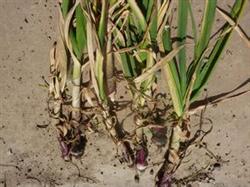Green Prevention and Control Technology of garlic Diseases and insect pests

Green prevention and control of crops is the use of agricultural prevention and control, physical prevention and control, biological prevention and control, precise drug use and other technologies to control diseases and insect pests in the process of agricultural production. to achieve the purpose of reducing the use of pesticides, reducing pesticide residues in agricultural products, and comprehensively improving the quality and safety level of agricultural products. This year, the planting area of garlic in our town has increased compared with the previous year. In order to ensure the normal growth of garlic, we should attach great importance to it, take active action, adhere to the plant protection policy of "prevention first, comprehensive control", vigorously promote green prevention and control technology, and reduce pesticide residues. to achieve the goal of high quality, high yield, high efficiency and meeting the needs of export agricultural products. The green prevention and control technology of garlic diseases and insect pests is mainly focused on the following aspects: first, agricultural prevention and control should take agricultural technical measures such as clean pastoral areas, scientific fertilization and irrigation, and strengthening the management of mid-tillage, so as to create ecological environmental conditions conducive to the growth of onions and garlic. the ecological environment conditions that are not conducive to the occurrence of diseases and insect pests, enhance the resistance of plants to diseases and insect pests and reduce the damage. Second, physical prevention and control one is the use of frequency vibration insecticidal lights to trap and kill adults of night moth pests, each frequency vibration insecticidal lamp can control an area of up to 30-50 mu; the second is to use the color habits of pests to trap and kill pests, such as winged aphids and Liriomyza sinensis with yellow viscose plates, and thrips by using blue viscose plates to hang 20-30 (20 × 24 mu) viscose boards per mu, which can effectively control the occurrence of insect pests. Third, the prevention and control of pesticides should be scientific and rational use of pesticides, and follow the principle of "strict, accurate and appropriate amount", prescribe the right medicine to the case and use pesticides alternately; strictly enforce the safety interval of pesticides and prohibit the use of pesticides with high toxicity and high residues; new application instruments are adopted to improve the atomization effect of the liquid, so as to reduce the amount of pesticides, improve the effectiveness of pesticides and improve the effect of prevention and control. 1. Chemical control of garlic leaf blight and purple spot: in the early growth stage of garlic and scallions, that is, before the seedling stage and flower bud differentiation stage, and before the tillering stage, 70% mancozeb WP 500x solution or 75% chlorothalonil WP 500x solution was used for spray prevention, once every 10 days, for 2-3 consecutive times. At the initial stage of the disease, 10% difenoconazole (Shigao) WG 4000-5000 times solution or 75% chlorothalonil WP 2500-3000 times solution or 25% propiconazole EC 2500-3000 times solution were selected for spray control, once every 7-10 days, 3-4 times continuously. 2. Insecticide control of Spodoptera exigua pests (Spodoptera exigua, Spodoptera litura, etc.): during the 1-2 instar stage of larvae of Spodoptera exigua (Spodoptera exigua, Spodoptera exigua, etc.), 5% cyhalothrin (Baishu) EC 2000-3000 times or BT ME 1000-1000 times or 50% fluflubenzuron EC 1000-1500 times were sprayed for 2-3 times every 7 days. 3. Chemical control of thrips: choose 10% imidacloprid WP 1000-1500 times liquid or 5% imidacloprid EC 1500-2000 times solution for spray control, every 7 days, continuous control 2-3 times, but also can prevent aphids. 4. Chemical control of Liriomyza huidobrensis: 1.8% avermectin EC 2000-2500 times or 50% EC 4000-5000 times were sprayed, once every 7 days for 2-3 consecutive times.
- Prev

It is necessary to understand the characteristics of fertilizer requirement for garlic to achieve high yield.
Garlic is a bulb crop which needs a large amount of fertilizer and is more tolerant to fertilizer. it is suitable to be cultivated in sandy loam soil which is rich in organic matter, loose and fertile soil surface, comprehensive nutrition, good water and fertilizer retention and ventilation. According to the study, for every 1000 kg of fresh garlic, it needs 4. 5-5 kg nitrogen, 1. 1-1. 3 kg phosphorus and 4. 1-4. 7 kg potassium.
- Next

Prevention of garlic Spring Rot in Spring
Garlic spring rot can last until mid-June, especially in low-temperature and humid years. It mainly harms the base of the lower leaf body. There is a water immersion softening spot, which expands in the up and down direction and shows light brown rot. In the middle and later stage of growth, the heart leaves became ill, and the softening and rot spread to the lower part of the flower stem. Sometimes it can lead to new.
Related
- Where is it suitable to grow horseradish in China? it is expected to see the middle altitude horseradish in Alishan.
- How to prevent tomato virus disease reasonably? (Control methods included)
- Many people like to plant towel gourd on the balcony. What are the main points of this method and management?
- What crops can chili peppers be mixed with?
- Fertilization techniques and matters needing attention in Tomato
- What are the grafting techniques for peach seedlings in spring?
- Harm and control methods of root swelling disease of Chinese cabbage
- What are the pests of sweet potatoes? How to prevent and cure it?
- Symptoms, causes and Control methods of navel Rot in Tomato
- The cause of "Cucumber rotten bibcock" in Farmers' planting Cucumber and its Control Plan

